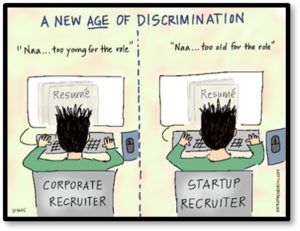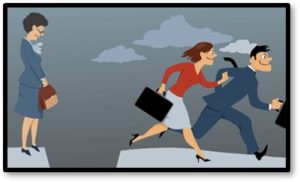Monday Author: Susanne Skinner
Racism, sexism and ageism are terms everyone knows. Of the three, ageism is the most openly practiced. Weak laws allow companies to engage in involuntary retirement, underemployment and financial restructuring with a bias against hiring and retaining older workers.
 A multi-generational workforce should be the norm. People live longer and many want to work past the traditional retirement age of 65. In the United States there are close to 120 million people fifty and older, an 80 percent increase over the past twenty years.
A multi-generational workforce should be the norm. People live longer and many want to work past the traditional retirement age of 65. In the United States there are close to 120 million people fifty and older, an 80 percent increase over the past twenty years.
Age discrimination is more than a denied promotion or job termination, it’s a matter of self-worth and professional esteem. Policies that force older workers into early retirement are against the law. It’s time to eradicate this outdated stereotype.
Older job seekers make up 20 percent of the nation’s work force. Many are kept from their full earning potential even though they contribute more than $8.3 trillion to the economy.
Protecting older workers against age discrimination allows them to continue contributing to society personally and professionally.
The Discrimination Model
One of the main reasons ageism remains a reality is our youth-based culture. Growing older is viewed as a liability. Companies create hiring models to attract young people, offering fewer opportunities, promotions and educational programs to workers over fifty.
The rise of technology eclipses an older workforce often viewed as unable to keep pace with its progress. Hiring biases center on the belief that an older worker is technology ignorant. A youthful workforce is the new normal, with recruiters favoring resumes of younger applicants.
The American business model is one of planned obsolescence. Human capital is disposable, and an aging workforce is replaceable. There is a shelf life to employees and when they exceed it, they are cast aside. Newer models are younger, less expensive and easy to recruit.
Acceptable Bias and Flawed Laws
Age Discrimination Employment Act (ADEA), passed in 1967, still finds many companies out of compliance or ignorant of its existence. If they believe they can get away with it, they’ll do it.
 It is the nation’s federal law against age discrimination, but it is also a weak one. It affords basic protection that did not previously exist but, unless a company is facing a class-action suit, it has very little to lose.
It is the nation’s federal law against age discrimination, but it is also a weak one. It affords basic protection that did not previously exist but, unless a company is facing a class-action suit, it has very little to lose.
The Supreme Court determined that the most an individual can be awarded is twice the amount of lost wages plus attorney fees. It also permits ‘reasonable factors other than age,’ so all a company must do is prove the action was financially driven.
The House of Representatives recently passed the Protecting Older Workers Against Discrimination Act (POWADA), giving older workers the same protections that exist for race, sex, ethnicity and religion. If the Senate passes this bipartisan bill, it will restore these rights (lost in a 2009 Supreme Court decision) limiting workplace age discrimination.
More than 1 million employment discrimination complaints have been filed with the government since 2010. In 82 percent of the cases the worker received a ‘no cause’ finding and no relief. Less than 2 percent of the cases proved a ‘reasonable cause’ finding.
Digital Age Discrimination
It’s easy to tweak a digital resume to remove dates and condense experience, but a digital application does not permit blank fields. Even with stellar credentials, older workers must give away their age and are ignored in favor of younger applicants.
In a recent AARP study nearly 5,000 Linked In job postings included the phrase “recent college graduate.” The frequency of this descriptor indicates companies are either unaware of the EEOC rules or chose to ignore them.
The Federal government warns employers these terms can be offered as evidence in age discrimination actions. Major job posting sites continue to use them with the belief that it will discourage older applicants.
Phrases like “digital native,” “measurable results,” and “inspired to work hard and party hard” appear in on-line postings. These words marginalize older job seekers and are considered discriminatory.
Businesses are not afraid to openly say they are not interested in hiring older workers.
The Company Point of View
Companies work hard to dodge the discrimination bullet. When downsizing, they falsify numbers by including younger people who serve as collateral damage. Citing financial performance and restructuring, they successfully use cost savings while denying age.
 If an employee acts against an employer, they bear the burden of proof. Even if an employee can prove an element of discrimination, if it is not the main reason for dismissal, the case is rejected.
If an employee acts against an employer, they bear the burden of proof. Even if an employee can prove an element of discrimination, if it is not the main reason for dismissal, the case is rejected.
Most people believe age discrimination begins when workers are in their fifties. According to AARP it is much broader, beginning in the mid-forties and going as high as seventy-five. Twenty-two percent believe it begins as early as the thirties. Tech companies are the biggest offenders.
Combating Workplace Age Discrimination
Sixty-five percent of employees above age 55 are strong contributors to the corporate bottom line. They also offer lower turnover rates and greater levels of experience.
 Yet some employers create intolerable working conditions to force resignations from older workers. The largest percentage of candidates not hired into a job cite age discrimination as the reason. The ADEA’s data supports this but they are unable to unilaterally enforce their own law. They focus only on cases they believe will have the broadest impact.
Yet some employers create intolerable working conditions to force resignations from older workers. The largest percentage of candidates not hired into a job cite age discrimination as the reason. The ADEA’s data supports this but they are unable to unilaterally enforce their own law. They focus only on cases they believe will have the broadest impact.
Age bias laws vary by state. Some states allow compensatory and well as punitive damages, but South Dakota has no state age discrimination laws. Until laws are changed, no change will take place.
POWDA amends the EDOA and ADA to restore the standard across the country.
If you think you’ve been discriminated against, you can file a charge with the Equal Employment Opportunity Commission. You can also work with a lawyer to file a lawsuit. Before taking these steps, consider going through your company’s mediation or grievance system. A lawsuit is expensive with no guarantee of success.
Related Posts
- Research Results Disprove Ageism Myths
- Age Doesn’t Matter, Ageism Does
- Ageism Debunked Again
- Millenials, Maturity and Antelopes

Realistically, short of recording someone saying something – and I’m not advocating this – it’s almost impossible to show beyond a reasonable doubt.
What I keep asking is this: “Do those who commit ageism not grasp they, too, are getting older?”